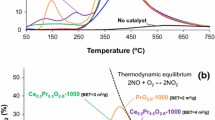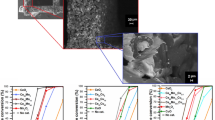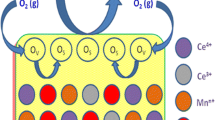Abstract
The effects of non-reducible dopants on copper–ceria catalysts for the preferential oxidation of carbon monoxide (CO PROX) were experimentally investigated by adding a non-reducible rare-earth element into the ceria support. Gadolinium-doped cerium oxides were synthesized by a combustion method as a support material for the copper–ceria catalytic system. Various compositions of the catalysts, i.e., CuO/Ce1−xGdxO2−δ (x = 0, 0.05, 0.1, 0.13, 0.18, 0.25 and 0.35), were prepared. The physical, structural, redox and surface chemical properties of the prepared catalysts were characterized by inductively coupled plasma mass spectrometry (ICP-MS), N2 isotherms, X-ray diffraction (XRD), Raman spectroscopy, transmission electron microscopy (TEM), H2 temperature-programmed reduction (H2-TPR) and X-ray photoelectron spectroscopy (XPS) analyses. To investigate the influence of the dopants on the CO PROX, an activity test was conducted for each sample under a reactant stream containing CO, H2, CO2 and H2O. Negative effects of the dopants on the CO PROX activity were experimentally observed. Several characteristics on the catalysts induced by the insertion of dopants caused the effects. The presence of the non-reducible dopants on the surface hindered the efficiency of the redox equilibrium between copper and cerium, which is the essential process for CO PROX. Surface oxygen vacancies, generated by the introduction of foreign dopants, were not beneficial to the CO PROX activity. Copper species on the catalysts might be penetrated through these vacancies and protected as non-reactive reduced form in these vacancies.
Graphical Abstract










Similar content being viewed by others
References
Ahmed S, Krumpelt M (2001) Hydrogen from hydrocarbon fuels for fuel cells. Int J Hydr Energy 26:291–301
Santacesaria E, Carrá S (1983) Kinetics of catalytic steam reforming of methanol in a cstr reactor. Appl Catal 5:345–358
Igarashi H, Fujino T, Watanabe M (1995) Hydrogen electro-oxidation on platinum catalysts in the presence of trace carbon monoxide. J Electroanal Chem 391:119–123
Tanaka H, Kuriyama M, Ishida Y, Ito S-I, Tomishige K, Kunimori K (2008) Preferential CO oxidation in hydrogen-rich stream over Pt catalysts modified with alkali metals: part I. Catalytic performance. Appl Catal A 343:117–124
Pozdnyakova O, Teschner D, Wootsch A, Kröhnert J, Steinhauer B, Sauer H, Toth L, Jentoft FC, Knop-Gericke A, Paál Z, Schlögl R (2006) Preferential CO oxidation in hydrogen (PROX) on ceria-supported catalysts, part II: oxidation states and surface species on Pd/CeO2 under reaction conditions, suggested reaction mechanism. J Catal 237:17–28
Wang L, Chen J, Patel A, Rudolph V, Zhu Z (2012) Catalytic performance of Ru nanoparticles supported on different mesoporous silicas for preferential oxidation of CO in H2-rich atmosphere. Appl Catal A 447–448:200–209
Han YF, Kahlich MJ, Kinne M, Behm RJ (2004) CO removal from realistic methanol reformate via preferential oxidation—performance of a Rh/MgO catalyst and comparison to Ru/γ-Al2O3, and Pt/γ-Al2O3, Appl Catal B 50:209–218
Adlhart Otto J, Cohn Johann GE, Walter E, Straschil Heinrich K (1971) Process for oxidation of carbon monoxide. Google Patents
Kim YH, Park ED, Lee HC, Lee D, Lee KH (2009) Preferential CO oxidation over supported noble metal catalysts. Catal Today 146:253–259
Avgouropoulos G, Ioannides T (2003) Selective CO oxidation over CuO–CeO2 catalysts prepared via the urea–nitrate combustion method. Appl Catal A 244:155–167
Costello CK, Kung MC, Oh HS, Wang Y, Kung HH (2002) Nature of the active site for CO oxidation on highly active Au/γ-Al2O3. Appl Catal A 232:159–168
Teng Y, Sakurai H, Ueda A, Kobayashi T (1999) Oxidative removal of co contained in hydrogen by using metal oxide catalysts. Int J Hydr Energy 24:355–358
Liu W, Flytzanistephanopoulos M (1995) Total oxidation of carbon monoxide and methane over transition metal fluorite oxide composite catalysts. J Catal 153:304–316
Liu Y, Fu Q, Stephanopoulos MF (2004) Preferential oxidation of CO in H2 over CuO–CeO2 catalysts. Catal Today 93–95:241–246
Guo Q, Liu Y (2008) MnOx modified Co3O4-CeO2 catalysts for the preferential oxidation of CO in H2-rich gases. Appl Catal B 82:19–26
Kandoi S, Gokhale AA, Grabow LC, Dumesic JA, Mavrikakis M (2004) Why Au and Cu are more selective than Pt for preferential oxidation of CO at low temperature. Catal Lett 93:93–100
Wu Z, Zhu H, Qin Z, Wang H, Huang L, Wang J (2010) Preferential oxidation of CO in H2-rich stream over CuO/Ce1–xTixO2 catalysts. Appl Catal B 98:204–212
Liu W, Flytzanistephanopoulos M (1995) Total oxidation of carbon-monoxide and methane over transition metal fluorite oxide composite catalysts. J Catal 153:317–332
Sedmak G, Hočevar S, Levec J (2004) Transient kinetic model of CO oxidation over a nanostructured Cu0.1Ce0.9O2–y catalyst. J Catal 222:87–99
Martínez-Arias A, Gamarra D, Hungría BA, Fernández-García M, Munuera G, Hornés A, Bera P, Conesa CJ, Cámara LA (2013) Characterization of active sites/entities and redox/catalytic correlations in copper–ceria-based catalysts for preferential oxidation of CO in H2-rich streams. Catalysts 3(2):378–400
Sedmak G, Hočevar S, Levec J (2003) Kinetics of selective CO oxidation in excess of H2 over the nanostructured Cu0.1Ce0.9O2–y catalyst. J Catal 213:135–150
Wang JB, Lin S-C, Huang T-J (2002) Selective CO oxidation in rich hydrogen over CuO/samaria-doped ceria. Appl Catal A 232:107–120
Lin R, Luo M-F, Zhong Y-J, Yan Z-L, Liu G-Y, Liu W-P (2003) Comparative study of CuO/Ce0.7Sn0.3O2, CuO/CeO2 and CuO/SnO2 catalysts for low-temperature CO oxidation. Appl Catal A 255:331–336
Chen Y-Z, Liaw B-J, Chang W-C, Huang C-T (2007) Selective oxidation of CO in excess hydrogen over catalysts. Int J Hydr Energy 32:4550–4558
Cecilia JA, Arango-Díaz A, Rico-Pérez V, Bueno-López A, Rodríguez-Castellón E (2015) The influence of promoters (Zr, La, Tb, Pr) on the catalytic performance of CuO–CeO2 systems for the preferential oxidation of CO in the presence of CO2 and H2O. Catal Today 253:115–125
Ratnasamy P, Srinivas D, Satyanarayana CVV, Manikandan P, Senthil Kumaran RS, Sachin M, Shetti VN (2004) Influence of the support on the preferential oxidation of CO in hydrogen-rich steam reformates over the CuO–CeO2–ZrO2 system. J Catal 221:455–465
Ayastuy JL, Gurbani A, González-Marcos MP, Gutiérrez-Ortiz MA (2012) Selective CO oxidation in H2 streams on CuO/CexZr1–xO2 catalysts: correlation between activity and low temperature reducibility. Int J Hydr Energy 37:1993–2006
Martínez-Arias A, Hungría AB, Fernández-García M, Conesa JC, Munuera G (2005) Preferential oxidation of CO in a H2-rich stream over CuO/CeO2 and CuO/(Ce,M)Ox (M = Zr, Tb) catalysts. J Power Sources 151:32–42
Hennings U, Reimert R (2007) Noble metal catalysts supported on gadolinium doped ceria used for natural gas reforming in fuel cell applications. Appl Catal B 70:498–508
Hernández WY, Laguna OH, Centeno MA, Odriozola JA (2011) Structural and catalytic properties of lanthanide (La, Eu, Gd) doped ceria. J Solid State Chem 184:3014–3020
Colussi S, de Leitenburg C, Dolcetti G, Trovarelli A (2004) The role of rare earth oxides as promoters and stabilizers in combustion catalysts. J Alloys Compd 374:387–392
Lee S, Bae M, Bae J, Katikaneni SP (2015) Ni–Me/Ce0.9Gd0.1O2–x (Me: Rh, Pt and Ru) catalysts for diesel pre-reforming. Int J Hydr Energy 40:3207–3216
Mosqueda B, Toyir J, Kaddouri A, Gélin P (2009) Steam reforming of methane under water deficient conditions over gadolinium-doped ceria. Appl Catal B 88:361–367
He D, Hao H, Chen D, Liu J, Yu J, Lu J, Liu F, Wan G, He S, Luo Y (2017) Synthesis and application of rare-earth elements (Gd, Sm, and Nd) doped ceria-based solid solutions for methyl mercaptan catalytic decomposition. Catal Today 281(Part 3):559–565
Marina OA, Bagger C, Primdahl S, Mogensen M (1999) A solid oxide fuel cell with a gadolinia-doped ceria anode: preparation and performance. Solid State Ionics 123:199–208
Andreeva D, Ivanov I, Ilieva L, Abrashev MV, Zanella R, Sobczak JW, Lisowski W, Kantcheva M, Avdeev G, Petrov K (2009) Gold catalysts supported on ceria doped by rare earth metals for water gas shift reaction: Influence of the preparation method. Appl Catal A 357:159–169
Ilieva L, Pantaleo G, Ivanov I, Zanella R, Venezia AM, Andreeva D (2009) A comparative study of differently prepared rare earths-modified ceria-supported gold catalysts for preferential oxidation of CO. Int J Hydr Energy 34:6505–6515
Purohit RD, Sharma BP, Pillai KT, Tyagi AK (2001) Ultrafine ceria powders via glycine-nitrate combustion. Mater Res Bull 36:2711–2721
Grazulis S, Chateigner D, Downs RT, Yokochi AFT, Quiros M, Lutterotti L, Manakova E, Butkus J, Moeck P, Le Bail A (2009) Crystallography open database: an open-access collection of crystal structures. J Appl Crystallogr 42:726–729
Lee HC, Kim DH (2008) Kinetics of CO and H2 oxidation over CuO–CeO2 catalyst in H2 mixtures with CO2 and H2O. Catal Today 132:109–116
Holland B (2003) Determination of both mesopores and macropores in three-dimensional ordered porous materials by nitrogen adsorption. J Porous Mater 10:17–22
Hennings U, Reimert R (2007) Investigation of the structure and the redox behavior of gadolinium doped ceria to select a suitable composition for use as catalyst support in the steam reforming of natural gas. Appl Catal A 325:41–49
Hong SJ, Virkar AV (1995) Lattice parameters and densities of rare-earth oxide doped ceria electrolytes. J Am Ceram Soc 78:433–439
Shannon RD (1976) Revised effective ionic-radii and systematic studies of interatomic distances in halides and chalcogenides. Acta Crystallogr A 32:751–767
Zhou XD, Huebner W (2001) Size-induced lattice relaxation in CeO2 nanoparticles. Appl Phys Lett 79:3512–3514
Halder NC, Wagner CNJ (1966) Separation of particle size and lattice strain in integral breadth measurements. Acta Crystallograph 20:312–313
Si R, Zhang Y-W, Li S-J, Lin B-X, Yan C-H (2004) Urea-based hydrothermally derived homogeneous nanostructured Ce1−xZrxO2 (x = 0–0.8) solid solutions: a strong correlation between oxygen storage capacity and lattice strain. J Phys Chem B 108:12481–12488
Gamarra D, Munuera G, Hungría AB, Fernández-García M, Conesa JC, Midgley PA, Wang XQ, Hanson JC, Rodríguez JA, Martínez-Arias A (2007) Structure–activity relationship in nanostructured copper–ceria-based preferential CO oxidation catalysts. J Phys Chem C 111:11026–11038
Mahata T, Das G, Mishra RK, Sharma BP (2005) Combustion synthesis of gadolinia doped ceria powder. J Alloys Compd 391:129–135
Sudarsanam P, Mallesham B, Reddy PS, Großmann D, Grünert W, Reddy BM (2014) Nano-Au/CeO2 catalysts for CO oxidation: influence of dopants (Fe, La and Zr) on the physicochemical properties and catalytic activity. Appl Catal B 144:900–908
Taniguchi T, Watanabe T, Sugiyama N, Subramani AK, Wagata H, Matsushita N, Yoshimura M (2009) Identifying defects in ceria-based nanocrystals by UV resonance Raman spectroscopy. J Phys Chem C 113:19789–19793
Weber WH, Hass KC, McBride JR (1993) Raman study of CeO2: second-order scattering, lattice dynamics, and particle-size effects. Phys Rev B 48:178–185
Nakajima A, Yoshihara A, Ishigame M (1994) Defect-induced Raman spectra in doped CeO2. Phys Rev B 50:13297–13307
Prasad DH, Park SY, Ji HI, Kim HR, Son JW, Kim BK, Lee HW, Lee JH (2012) Structural characterization and catalytic activity of Ce0.65Zr0.25RE0.1O2–δ nanocrystalline powders synthesized by the glycine-nitrate process. J Phys Chem C 116:3467–3476
Trovarelli A (2002) Catalysis by ceria and related materials. Imperial College Press, London
Hegde MS, Madras G, Patil KC (2009) Noble metal ionic catalysts. Acc Chem Res 42:704–712
Konsolakis M, Ioakeimidis Z (2014) Surface/structure functionalization of copper-based catalysts by metal-support and/or metal–metal interactions. Appl Surf Sci 320:244–255
Zhu H, Qin Z, Shan W, Shen W, Wang J (2004) Pd/CeO2–TiO2 catalyst for CO oxidation at low temperature: a TPR study with H2 and CO as reducing agents. J Catal 225:267–277
Zou H, Dong X, Lin W (2006) Selective CO oxidation in hydrogen-rich gas over CuO/CeO2 catalysts. Appl Surf Sci 253:2893–2898
Ayastuy JL, Gurbani A, González-Marcos MP, Gutiérrez-Ortiz MA (2010) CO oxidation on CeXZr1–XO2-supported CuO catalysts: correlation between activity and support composition. Appl Catal A 387:119–128
Pintar A, Batista J, Hočevar S (2005) TPR, TPO, and TPD examinations of Cu0.15Ce0.85O2–y mixed oxides prepared by co-precipitation, by the sol–gel peroxide route, and by citric acid-assisted synthesis. J Colloid Interface Sci 285:218–231
Liu W, Flytzani-Stephanopoulos M (1996) Transition metal-promoted oxidation catalysis by fluorite oxides: a study of CO oxidation over Cu·CeO2. Chem Eng J Biochem Eng J 64:283–294
Kundakovic L, Flytzani-Stephanopoulos M (1998) Reduction characteristics of copper oxide in cerium and zirconium oxide systems., Appl Catal A 171:13–29
Luo M-F, Zhong Y-J, Yuan X-X, Zheng X-M (1997) TPR and TPD studies of CuOCeO2 catalysts for low temperature CO oxidation. Appl Catal A 162:121–131
Sanchez MG, Gazquez JL (1987) Oxygen vacancy model in strong metal–support interaction. J Catal 104:120–135
Holmgren A, Azarnoush F, Fridell E (1999) Influence of pre-treatment on the low-temperature activity of Pt/ceria. Appl Catal B 22:49–61
Kotani A, Jo T, Parlebas J (1988) Many-body effects in core-level spectroscopy of rare-earth compounds. Adv Phys 37:37–85
Avgouropoulos G, Ioannides T (2006) Effect of synthesis parameters on catalytic properties of CuO–CeO2. Appl Catal B 67:1–11
Svintsitskiy DA, Kardash TY, Stonkus OA, Slavinskaya EM, Stadnichenko AI, Koscheev SV, Chupakhin AP, Boronin AI (2013) In situ XRD, XPS, TEM, and TPR Study of highly active in CO oxidation CuO nanopowders. J Phys Chem C 117:14588–14599
Dow WP, Huang TJ (1994) Effects of oxygen vacancy of Yttria-stabilized zirconia support on carbon monoxide oxidation over copper catalyst. J Catal 147:322–332
Choi Y, Stenger HG (2003) Water gas shift reaction kinetics and reactor modeling for fuel cell grade hydrogen. J Power Sources 124:432–439
Ahluwalia RK, Zhang Q, Chmielewski DJ, Lauzze KC, Inbody MA (2005) Performance of CO preferential oxidation reactor with noble-metal catalyst coated on ceramic monolith for on-board fuel processing applications. Catal Today 99:271–283
Gamarra D, Martinez-Arias A (2009) Preferential oxidation of CO in rich H-2 over CuO/CeO2: operando-DRIFTS analysis of deactivating effect of CO2 and H2O. J Catal 263:189–195
Di Benedetto A, Landi G, Lisi L, Russo G (2013) Role of CO2 on CO preferential oxidation over CuO/CeO2 catalyst. Appl Catal B 142–143:169–177
Gawade P, Bayram B, Alexander A-MC, Ozkan US (2012) Preferential oxidation of CO (PROX) over CoOx/CeO2 in hydrogen-rich streams: effect of cobalt loading. Appl Catal B 128:21–30
Acknowledgements
This work was supported by the New & Renewable Energy Core Technology Program of the Korea Institute of Energy Technology Evaluation and Planning (KETEP) granted financial resource from the Ministry of Trade, Industry & Energy, Republic of Korea (No. 20153010031930). Also, this work was supported by the Global Frontier R&D Program on Center for Multiscale Energy System funded by the National Research Foundation under the Ministry of Science, ICT & Future, Korea (2011–0031569). Additionally, the authors with to thank Saudi Aramco, Saudi Arabia for the financial assistance and permission to publish results.
Author information
Authors and Affiliations
Corresponding author
Electronic supplementary material
Below is the link to the electronic supplementary material.
Rights and permissions
About this article
Cite this article
Oh, J., Yoo, J.D., Kim, K. et al. Negative Effects of Dopants on Copper–Ceria Catalysts for CO Preferential Oxidation Under the Presence of CO2 and H2O. Catal Lett 147, 2987–3003 (2017). https://doi.org/10.1007/s10562-017-2188-0
Received:
Accepted:
Published:
Issue Date:
DOI: https://doi.org/10.1007/s10562-017-2188-0




